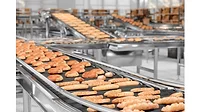Automation
Automation’s role in future food factories

In a recent food processing market research report by PMMI, The Association for Packaging and Processing Technologies, 50 percent of food manufacturers indicated that operational improvements involving automation would receive the most attention over the next three to five years.
Additionally, 20 percent indicated an interest in upgrading the use of robotics on their production lines. These initiatives come from a variety of factors driving innovation across both automation and robotic equipment investment and development. In fact, 30 percent of processing operations and 94 percent of packaging operations use robotics, with both sectors predicting growth. Food processors and manufacturers are anticipating investments in these areas due to unique consumer demands, employee retention and training challenges, recall management, track and trace and remote equipment diagnosis to name a few. However, it all seems to boil down to one thing across all parties, and that is convenience.
Automation for the Needs of Consumers
Consumer-driven health and wellness trends, specialized ingredient choices and dieting demands have initiated an explosion of SKUs for the average food processor and brand manager to produce. For instance, clean label, organic, additive-free, non-GMO, gluten-free or allergen-free products each require a unique SKU. Four out of five food processing companies indicated in PMMI’s 2017 Trends in Food Processing Operations that they currently operate with more than 100 product SKUs, and over half of them predict that SKUs will continue to increase in the coming years.
The SKU explosion has changed the way food processors measure speed and throughput. Rather than focusing on the speed of total production throughput, food processors and manufacturers are considering changeover speed as an integral part of adapting to consumer desires for a large variety of products. Flexibility to accommodate changeovers for single-use and bulk packaging sizes or the ability to quickly sanitize production lines before switching from gluten to non-gluten products, for instance, can increase production speed. Seventy-three percent of food processors included in PMMI’s report indicated a desire for a new generation of processing equipment that offered improved cleanability.
Food Processors Leaning on Automation
Ensuring food processing equipment complies with regulations such as the Food Safety Modernization Act (FSMA), and integrating automated track and trace systems with SKU creation have become the first-line of defense for food processors when managing a recall. By tracking every aspect of the supply chain, food processors can zero-in on the source of an adulterated or contaminated product, how and when it entered the operation, where it had traveled since and potentially where and when the contamination began.
While innovation in automation and robotics has increased in the food processing supply chain, so has the need to maintain and service these instruments. More than half of food manufacturers are using customized equipment and look to original equipment manufacturers (OEM) for integrating maintenance and service. Moreover, food processors are looking to OEMs to provide remote diagnostic services or integrate preventative maintenance features directly into their equipment interfaces. Seventy-seven percent of food manufacturers echoed these sentiments, stating that their suppliers currently offer remote diagnostic access. In the future, nearly half the companies predict using remote access nearly 50 percent of the time. As staff shortages continue to affect manufacturing in general, food processors rely more than ever on their suppliers for troubleshooting and repairs, rather than calling on technicians and halting operations.
Employment Concerns
Training and retaining skilled talent to operate a line of automated machinery or robotic equipment continues to be a challenge for food processors. In fact, recruiting, training and retaining skilled employees to operate automated machinery remain one of the critical concerns of food manufacturers for 2017. To put labor demands into perspective, there was approximately a 5 percent reduction of employees within the food manufacturing sector while the number of food and beverage manufacturers increased by nearly 15 percent from 2008 to 2014. To remedy the situation, food manufacturers are looking toward suppliers to simplify equipment with more intuitive human machinery interfaces (HMI) and toolless assembly and repair, while also replacing difficult repetitive jobs with intuitive automated machinery.
At the upcoming inaugural ProFood Tech (McCormick Place, Chicago; April 4–6, 2017) powered by global trade show leaders PACK EXPO, Anuga and the International Dairy Foods Association (IDFA), attendees can address automation inquiries and labor concerns with industry professionals. For instance, on Wed. April 5, 11:30 a.m. – 12:00 p.m. the Innovation Stage at ProFood Tech presentation Filling Your Labor Shortage with Robotic Automation will cover how to reduce work-related lost time, downtime and speeding up production processes through automation solutions. Additionally, on Wed. April 5, 9:45 a.m. – 10:30 a.m. attendees can discover how in-line food sensors, drones and robots will be changing the food processing industry and food delivery services in the near future, making today’s challenges a thing of the past by viewing the ProFood Tech Conference Program, Food Plant of the Future: Are You Ready for New Technology?
For more detailed information on food processing industry trends, download PMMI’s 2017 Trends in Food Processing Report.
For more information or to register, visit www.profoodtech.com.
Looking for a reprint of this article?
From high-res PDFs to custom plaques, order your copy today!







